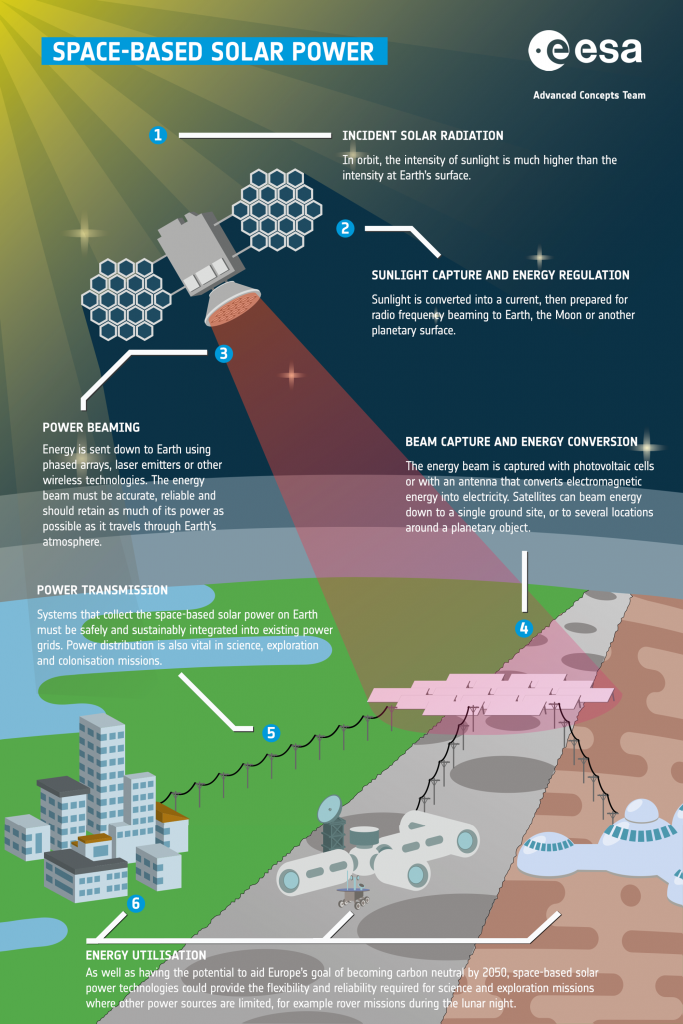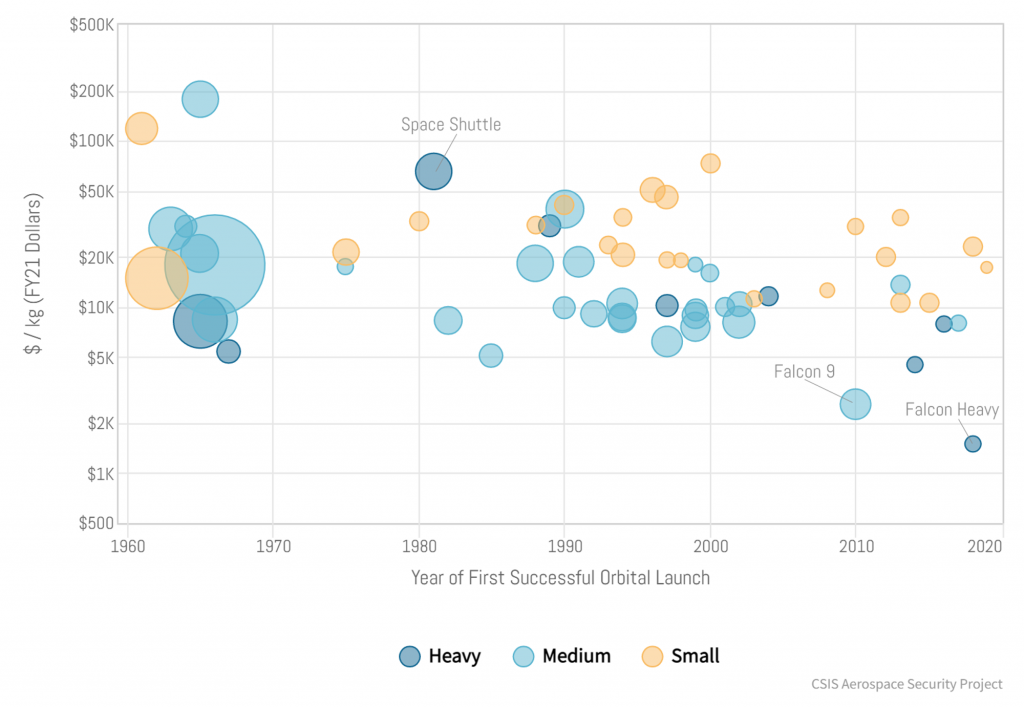In today’s article, I want to introduce you to the concept of space-based solar power. Let’s have a look at how the intersection of aerospace & energy is forming a revolution for our energy system.
Space-Based Solar Power or SBSP could solve all the problems current renewable energy systems like wind and solar are facing. Including intermittency, seasonality, and storage – and still, most people don’t even know that this technology exists.
From time to time, we must take a look to the horizon to broaden our perspective. Sometimes, we can’t see the bigger picture. We need to zoom out to find “outworldly” solutions which help to solve our problems. This is true for the energy sector, but equally so for ever other sector.
By looking beyond your own industry & education, you can tap into a much larger solution space than your competitors. This gives you an unfair unique advantage.
What Is Space-Based Solar Power (SBSP) And Why Is It Becoming Important Now?
Space-based solar power or Space Solar Power (SSP) is a technology to:
- Capture solar power with giant satellites in space,
- Transmit the power wirelessly to Earth,
- Transform the wireless transmission back into power at a receiver station to feed it into the grid.
Originally imagined by Isaac Asimov in his short story “Reason” (1941), space-based solar power was dormant until the 1960s. US engineer Peter Glaser really dreamt up the concept in 1968, designing the first proposals.
There are essentially 3 different ways which can be used to send energy down to Earth from space:
- Mirrors can reflect sunlight directly to a point on Earth where it can be converted by solar PV or other solar technologies
- Lasers could be used to send the energy collected in space in a concentrated high-power beam, but can experience higher losses due to weather and atmospheric scattering
- Microwaves represent another option for beaming power down to Earth, but can be operated independent of the weather and experience lower losses (essentially, it’s a more powerful WiFi or your mobile phone connection)
Although there are many alternative designs, most concepts for terrestrial applications focus on microwave-based systems. Therefore, I will focus on this concept in the following sections.
But why go through so many conversion steps? Why the hassle of shooting solar panels into space, if we can just place solar panels on the ground? Let’s take a quick look at the advantaged and disadvantages.
Advantages of Space-Based Solar Power (SBSP)
A space-based solar power system consists of three major components:
- The solar power generator,
- Microwave antennas, which convert the electricity to microwaves, and
- at least one receiver station to convert microwaves back to power.
The first two components are based on a Solar Power Satellite (SPS), while the receiver station is based on Earth. Let’s compare this three-step system to the simpler process plugging wind and solar PV plants into our grid. It isn’t directly obvious why SBSP could make sense in the first place.
Traditional renewables like solar PV, onshore wind, and offshore wind are all facing the same problem. They are not available continuously around the clock. Their intermittent nature leads to rapidly changing generation volumes every hour. We require energy storage and flexible consumers to counteract this. In addition, if the weather conditions are bad, renewable generation can drop to a minimum for weeks in a row.
Don’t get me wrong, like you, I love renewables. I’ve even studied them. But that also made me aware of their shortcomings. Storage is expensive and limited. So, we need massive backup capacities which can flexibly fire up their generation when wind and solar won’t produce enough power. And there are only two option we currently have for that. Either fossil-fuelled plants, especially natural gas fired ones, or (in the future) hydrogen-fired plants.
One note on nuclear fission: It isn’t as flexible as we would wish. Currently, most run as pure baseload and have to run at a minimum load at all time – even if renewables are generating enough. It also means, they are not the right choice as backup power, because we can’t have dozens of GW of nuclear plants standing around, waiting for a few hours of peak load. Nuclear fission might be a good baseload technology which could reduce the need for (intermittent) renewables and backups, but we will always need highly flexible backup capacities.
SBSP provides fully controllable peak & backup capacity 24/7, 365 days a year
Space-based solar power, on the other hand, has many advantages that make it not just another renewable in the mix. SBSP has the potential to supply fully controllable peak and backup capacity as well as continuous baseload around the clock.

On Earth’s surface the sun’s irradiance (the power delivered per square-metre) can reach up to 1000 W/m². That is for a cloudless day at sea level at the Equator and only at noon. However, ground-mounted solar does often not perfectly align with the sun since it doesn’t track the sun’s movement. This leads to a much lower average irradiance on Earth-based solar PV.
Outside of our atmosphere, the solar irradiance is constantly at 1361 W/m². 24/7. 365 days a year.
While Earth-based solar PV usually reaches load factors of 11-16 % in Europe (appx. 1000 to 1400 full load hours, space-based solar power can reach 100 %. There is no day-night cycle and no weather in space to interrupt the sunlight. This means, the same solar PV cell in space will produce 6-9 times as much power as its Earth-bound twin. The currently achievable efficiency of converting to microwaves and back to power is 50-60 % according to ESA. Considering this, we can produce 3-5 times as much energy as on Earth – continuously through day & night. However, this is not the physical limit for the efficiency. Further research & development could increase that efficiency much to much higher levels. Therefore, we could generate even more power and use less land with continuous research and development driving up the efficiency.
SBSP needs much less land area than solar PV would need
We can convert microwaves much more efficiently into power than we can convert light. Thus, for the same peak power, we only need a third to half of the land compared to solar PV. That is if the microwave power levels are, i.e., only one fourth of the sun’s power. Current designs use such low-intensity beams that are expected to be safe for planes, satellites, birds, and people. However, more extensive research will need to be done in the coming years to confirm this.
Some people in the industry argue that we should use much higher power densities, because it would enable much smaller land area consumption as well as potentially smaller antennas in space. To ensure the safety of such a beam, it would be necessary to include automatic instant shutdowns if anything passes through a “safety curtain” around the beam. In addition, the beam has to be super precise, showing no spilling or reflection around the receiver. This technology already exists today and has been demonstrated by EMROD before.
Space-based solar power can provide energy anywhere
However, the one of the biggest advantages of space-based solar power is that it can easily switch between targeted receivers. This means when there is a need for energy in Germany, it supplies its power to a receiver here. But sometimes wind and solar on the ground provide enough power for the region. The same satellite can then transfer its energy to another country anywhere else in its view.
But not all that glitters is gold.
Disadvantages of Space-Based Solar Power (SBSP)
Right now, SBSP is too expensive comparing to other technologies. This is primarily due to the extremely high rocket launch cost. On top, SBSP loses most of the extra sun it gets due to the conversion to microwaves & back to power. The efficiency has already improved in lab tests over the past years, but it’s still not where it must be. The microwave transmission itself is highly efficient, because the waves are not easily absorbed. Also, the receiver, the rectifying antenna, already achieves up to 85 % efficiency today. But the largest losses are currently caused by the microwave generators, when power is converted into electromagnetic waves.
Another difficulty is the engineering challenge of creating a self-assembling megastructure in space. It simply hasn’t been done before and requires solving various obstacles in robotics and automation in advance.
And finally, transferring energy via microwaves and lasers sounds bad to many people. While the designs make it impossible to produce any harmful radiation, most people won’t know that. The education of the wider public about its safety will be crucial for its success. And in addition, regulatory hurdles must be overcome to integrate this new technology into energy markets around the world.
Why is Space-Based Solar Power (SBSP) Becoming Important Now?
Since then, a lot of research was put into verifying the feasibility of the concept. Especially looking at cost and benefits of such a system:
- In 1976, NASA conducted a study on space based solar power satellites (SPS) that would collect solar energy in orbit and beam it to Earth via microwaves.
- In 1999, NASA launched a small satellite called Space Solar Power Exploratory Research and Technology (SERT) that tested some technologies for space based solar power.
- In 2008, ESA initiated a project called Space-based Solar Power (SBSP) that aimed to explore the feasibility and potential benefits of space based solar power for Europe.
After a couple more activities, space-based solar power was neglected, due to a simple reason. Every study showed that the cost of launching the required materials were way too high. It simply rendered the idea economically unfeasible.
However, this is changing rapidly.
Rocket launch costs are dropping rapidly, like “10x” rapidly.
Over the past 15 years the cost per kg for launching things into space have drastically decreased. This was primarily due to the rise of SpaceX and their reusable rockets. In the graph below, you can see the cost per kg by rocket and year of first successful launch. You can see, launch costs have decreased by close to 90 % since 2000! SpaceX is at the forefront of pushing prices in the industry down with their Falcon 9 and Falcon Heavy rockets. And they are far ahead of any other rocket launcher now.

Many researchers believe that we are closing in on the tipping point when space-based solar power becomes not only economically feasible, but heavily competitive compared to Earth-based wind and solar. John Mankins, who is a recognised expert on SBSP and has been involved in nearly all feasibility studies done by NASA, expects this level to be at around 300 $/kg.
SpaceX’s Elon Musk expects that their full and rapidly reusable rocket Starship will achieve down to 10 $/kg within this decade. This would enable a rapid build-up of capacity within the next decades.
And this trend did not go unnoticed.
The World Is in a Race to the First Space-Based Solar Power (SBSP) Plant
You might not know it yet, but there is a brand-new space race going on. And this time, nations and companies alike are rushing to be the first who implements space-based solar power on a gigawatt-scale. Let me introduce you to some of the most important programs now.
Solaris by ESA
Motivated primarily by the climate crisis and the need to achieve Net Zero, but also more recently by Europe’s energy crisis caused by the war in Ukraine, the European Space Agency (ESA) has launched two feasibility studies in early 2022. Frazer-Nash and Roland Berger analysed the costs and benefits of two different SBSP concept in these studies. Both concluded that space-based solar power has the potential to become a competitive renewable energy source by the end of the next decade. In the longer term, it could even become cheaper than solar and wind – but without their intermittency.
Based on these results, the ministerial council in November 2022 granted a significant budget to ESA, to conduct technical research and more advanced feasibility studies until 2025 as part of the SOLARIS project. Based on its results, there will be another decision point in 2025. Then, it will be decided whether Europe pushes strongly for the build-up of SBSP capacity. This would aim for developing and constructing plants at commercial scale within the 2030s.
Space Energy Initiative in the UK
Also in 2022, the Space Energy Initiative was announced in the UK. It is a collaboration of energy and space organisations, academia and research agencies with a single goal. They want to develop space-based solar power for the UK.
To help reach net-zero emissions, they want to build the first orbital demonstrator plant by 2030. And by 2040 they want to have the first operational system supplying power to the grid.
It’s 69 members include various aerospace companies like Airbus and Axiom Space. Also, governing bodies like the UK Department for Business, Energy & Industrial Strategy, and several universities, consultancies, and startups.
China has already committed (a bit)
In 2022, China already launched and tested a couple of systems required for SBSP, including microwave energy transmission. Using the Zhuhai research satellite, they carried out a 300m line-of-sight microwave transmission and tested a full-system model of a receiver power station at Chongqing University.
China has stated the goal to deploy a 1 Megawatt solar energy station by 2030 and scale it up to 1 Gigawatt by 2050. China’s primary hope is that this will provide reliable power for energy-hungry satellites, remote areas, and emergency situations.
Caltech’s $100M donation-funded Space-Based Solar Power Project
Yep, you read that correctly. Over the past decade, the California Institute of Technology (Caltech) received more than $100 million in donations from Donald and Brigitte Bren to fund the Space-Based Solar Power Projects (SSPP).
This allowed Caltech to employ the team working on SBSP continuously and without losing focus, e.g., due to grant writing and short-term contracts. Since 2016, they have published 89 papers (as of 04.03.2023) on space-based solar power, and advanced a series of enabling technologies, including lightweight solar panels, flexible space structures, wireless power transfer. But the best is yet to come.
Now, in early 2023, Caltech has launched a first set of technology demonstrators which will test their solar collector designs as well as wireless power transfer using microwaves.
So, as you can see, there is a lot going on. But researchers and public institutions are not the only ones looking into space-based solar power. There are a few startups and established companies who are aiming to provide space power to Earth – or contribute a few components at least.
These startups are making space-based solar power a reality
Of course, there are not only public institutions and space agencies working on this, but a lot of startups have gathered around to make the dream of space-based solar power come true! Check them out below!

Space Solar
Space Solar is a British company which single corporate priority is “To develop Space-Based Solar Power for the benefit of our stakeholders and the world”. It was founded by the same people who originally established the Space Energy Initiative in the UK.
One of their founders and Chief Architect is Ian Cash, who designed the CASSIOPeiA concept for a novel space-based solar power satellite. This model was used by Frazer-Nash in the UK’s and ESA’s feasibility studies and has proven competitive. Due to this, they state that they will be able to deliver Gigawatt-scale power within twelve years and first commercial power within 9 years!
The team consisting of Co-CEOs Martin Solltau, Sam Adlen, and CTO David Homfray has extensive experience in managing three-digit multi-million-dollar projects, including Mars missions and works at the nuclear fusion reactor JET.
IECL
IECL or International Electric Company Limited is the company of Ian Cash which developed the CASSIOPeiA concept. Its focus on designing and manufacturing innovation solutions in the area of wireless power transfer and renewable energy. Their phased-array technology aims at enabling new applications in many sectors utilising wireless power transfer.
Virtus Solis is a US-based startup, founded in 2018, which develops space-based solar power aiming to provide the full systems. Their sole mission is “To provide clean, low-cost renewable energy that directly supplants primary energy production for all terrestrial uses and eventually even extra-terrestrial”.
They were awarded $200,000 for the NASA Centenniel Challenge: Watts on the Moon Phase 2, where they delivered power from a variable source across 3km to a load on the other end.
They team around CEO John Bucknell and CTO Dr. Edward Tate aims to use a hyper-modular design for SBSP-satellites to optimise manufacturing and construction while driving down costs of energy.
Solestial
Solestial is a US-based company that develops and produces ultra-thin and lightweight solar cells for space. Due to their reduced mass, high efficiency, and a fully automated production process, they are enabling 90 % lower costs of power for satellites in space than current systems, according to Solestial.
Furthermore, they have recently closed their oversubscribed seed round at $10 million, led by Airbus Ventures. But they are not limiting themselves to satellites.
“Looking ahead, Solestial is uniquely positioned to enable long-lasting, highly efficient infrastructure for Earth orbit, cislunar space, and operations on the Moon itself, helping unlock the energy and resources of our whole planetary system for the benefit of life on Earth.” says CEO Stan Herasimenka.
mPower
Similarly, mPower is in the business of manufacturing high-efficiency, state-of-the-art silicon cells for space applications. Their “DragonSCALES” system is based on a standardised approach which builds on the massive scale of Earth’s silicon PV market to minimise costs.
And just one week ago, the team around CEO Kevin Hell announced a strategic partnership and factory expansion together with GTM Advanced Structures for fully automated and high-volume space panel manufacturing.
EMROD
EMROD is an American company that is 100 % focused on wireless power transmission. They have subsidiaries in Germany and New Zealand, and their research and development centre is located in New Zealand, too. The team around CEO Greg Kushnir has developed a clear use case roadmap for their technology, starting with terrestrial wireless power transmission. For this, they have already signed contracts and ran first field trials with Powerco & Ara Ake in New Zealand to test transmission via microwaves for rural areas. These tests were run across a couple of hundred metres. For early next year, they are planning additional pilot projects in the energy sector, with more details being announced soon.
In 2022, they demoed their technology in Munich in collaboration with ESA, Airbus, and Technocarbon. Currently their business focus for terrestrial applications lies on the connection of renewable energies to the grid where conventional grid connections would take years to be build and cost 10 times more. For example, they can easily connect a new wind or solar farm within 6 months instead of 6 years to the grid at about 10 % of the traditional line costs according to CEO Greg Kushnir.
Solar Space Technologies
Solar Space Technologies is an Australia-based company founded by Serdar Baycan, and supported by John Mankins, according to their website. John Mankins has been one of the leading forces in most of the feasibility studies facilitated by NASA over the past decades and a world-wide renowned expert in the field of space-based solar power. He is also advisor to a couple of other SBSP startups.
Summary
As you can see, space-based solar power is not just a science-fiction dream. It’s getting real, surprisingly fast and you will probably be around to witness the first plants going online.
See you next week. 😉 (Haven’t subscribed to The Climate Innovator newsletter yet? Join here!)






Excellent overview – thank you.
As a ‘green activist’ I can see the tremendous potential here. Just a dozen GEO satellite systems could replace our fossil fuel energy generation.
In a sane world making this happen would not be dependant on private funding, the government should be stepping in to future-proof the UK by making it far more energy self sufficient. If it can spend £100bn (?) on something as highly questionable as HS2 ………
I agree. However, speaking from a government perspective, space-based solar power is still out in the stars, while other technologies are here already. To act responsibly when spending tax payers’ money, they also need to look at the solutions which have proven themselves today.
And SBSP still needs a few years (or decades) to contribute in a meaningful way to the power sector. But of course, there are other sectors which need abatement, too. And for example old stone cottages on the UK countryside are more difficult to heat without H2 for example.
I liked the idea and method of implementation.
To form tendencies of development of future researches and developments, to promote integration processes of space programs, to expand communications of realization of joint researches.
Lars,
Another advantage to space based solar power is reducing in the need for grid build out. Since space based solar power is both a power generation and power distribution system, it can dramatically reduce the potential $21 trillion dollar grid build out required for renewables ( https://about.bnef.com/blog/global-net-zero-will-require-21-trillion-investment-in-power-grids/ ). Existing wind and solar farms can be supplemented with space based solar to boost their capacity factors to almost 100% with minimal grid improvements. Most importantly, the need for continental scale power transmission systems can be reduced or eliminated.
Ed
Lars,
this is superb article. Like Space industry where competition is through collaboration. so should the future of SBSP success be progressing through genuine global collaboration.
Off course each stake holders would rightfully protect its commercial interest but global collaboration with shorten the time to succeed.
For Artemis project even on the Moon SBSP could supply power seamlessly around the global clock
I have few highly profitable and achievable prospects in India and in turn save mother earth from making it berried land of solar module or a graveyard, which I think is criminal ?